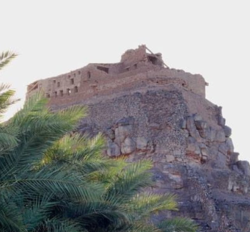
The visit to Israel by a Saudi Arabian ex-general, Anwar El-Eshki and his delegation, might herald a new dawn in Saudi-Jewish relations, in which Jewish visitors to the kingdom might be able to see for themselves sites of Jewish interest. The Times of Israel reports (with thanks: Lily):
These are five top Jewish spots in Saudi Arabia, to savor online for now, and just maybe up close in the near future:
1) Khaybar is situated in a valley with natural wells that have irrigated the area since ancient times, aiding in the growth of dates known throughout the country. The oasis made Khaybar a regular stop along the incense trade route from Yemen to the Levant, which is why it was the home of the Jewish community at the time. Visitors can also stop at the Jewish cemetery, a 1,400-year-old graveyard without any headstones but known locally for its Jewish history.
2) There’s also the Khaybar Fortress, perched on a hill overlooking the oasis, which is at least 1,400 years old. The earliest accounts of its construction date from the Battle of Khaybar, when the Prophet Mohammed and his army invaded and conquered Khaybar. It was Mohammed’s nephew and son-in-law, Ali, who was able to unlock the gate of the fortress to allow the Muslim armies to finally conquer the fortress. It was rebuilt and reused several times, but is still usually referred to it as the Fortress of the Jews.

Khaybar fortress (Wikimedia Commons)
3) The Palace of the Jewish Tribe’s Head is also located in Khaybar, and was the home of the Jewish tribe of Marhab. The tribe was known to be wealthy from dealing in gold and jewelry, and the palace it lived in is above the town, about a ten-minute climb from the center.
4) In Tayma, which was often referred to as a fortified city belonging to the Jews, most travelers stop at the Al-Naslaa Rock Formation, located in the Tayma oasis. It’s considered to have one of the most photogenic petroglyphs, or rock art, depicting the life and times of ancient communities. Al-Naslaa is also known for the perfect, natural slit between the two standing stones. Experts say the cause of this perfect slit could be the ground having shifted slightly underneath one of the two supports.
5) At the center of Tayma is Bir Haddaj, a large well considered to be about 2,500 years old, dating back at least to the middle of the sixth century BCE. It wasn’t in use until the 1950s, when it was repaired and later restored to its previous appearance.
The well is mentioned in the Book of Isaiah as the place where the descendants of Ishmael’s son, Tema, lived: “Unto him that is thirsty bring ye water! The inhabitants of the land of Tema did meet the fugitive with his bread.”
There are also the famous Tayma stones inscribed in Aramaic that are now in the Louvre Museum. Thousands of other Aramaic inscriptions that have been found in the area are stored in the city’s museum.

Leave a Reply